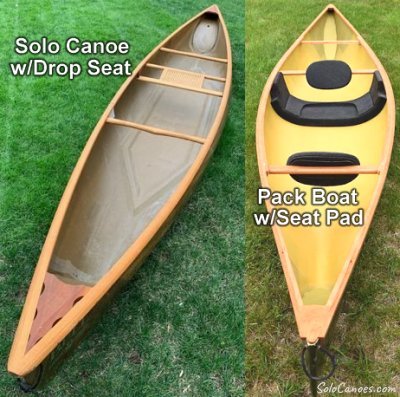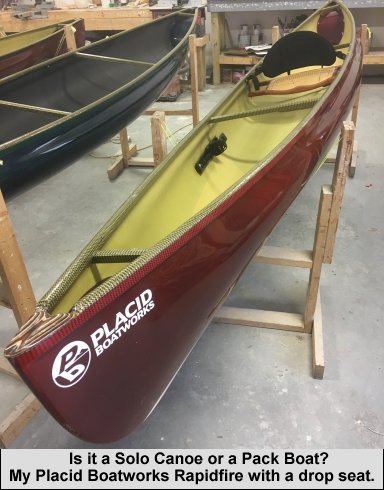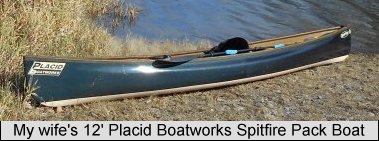





























|  |

|
 |
What's the difference between
a Solo Canoe and a Pack Boat?
Choosing a Solo Canoe or a Pack Boat…
What's the difference?
And why not a kayak?
|
2/23/2021
Pack Boats (or Pack Canoes) were designed to hold a single paddler with gear and supplies but still be light enough to carry long distances between Adirondack ponds and lakes.
A Canoe or Pack Boat with its single center seating position gives a person better positioning to paddle and control the canoe over paddling a tandem canoe by themselves.
By sitting toward the center balance point, the boat stays more level in the water (trim) which helps the canoe move in a straight line (called tracking). It gives the paddler better control wasting less energy.
Note the canoeist in the photo at the very top of this page paddling a tandem canoe alone from the rear seat. Notice how much the bow is out of the water making it harder for the canoe to track in a straight line.
Hint - if you have a tandem canoe (two seats) you want to paddle solo, try paddling it facing backwards while sitting in the bow seat. This gets you closer to the center of the canoe.
 At a quick glance, a pack boat (or Pack Canoe) looks like a solo canoe with the paddler sitting toward the middle.
But unlike a solo canoe with higher sides and seat, you sit in a pack boat lower to the water
line similar to a kayak.
A pack boat can have a very low seat on the bottom or just a pad for the paddler to sit on. This makes the pack boat more stable (less tippy) in the water. Sitting low in the water, pack boats are typically paddled using a double blade
kayak paddle. Many also have adjustable foot pegs and back bands (seat backs) like a kayak for comfort and to get more energy out of your paddle stroke.
At a quick glance, a pack boat (or Pack Canoe) looks like a solo canoe with the paddler sitting toward the middle.
But unlike a solo canoe with higher sides and seat, you sit in a pack boat lower to the water
line similar to a kayak.
A pack boat can have a very low seat on the bottom or just a pad for the paddler to sit on. This makes the pack boat more stable (less tippy) in the water. Sitting low in the water, pack boats are typically paddled using a double blade
kayak paddle. Many also have adjustable foot pegs and back bands (seat backs) like a kayak for comfort and to get more energy out of your paddle stroke.
Where the water gets muddy between them… (pun)
There is a fine line between a solo canoe and a pack boat. Having no seat and being too low in the water to use a single blade paddle defines a typical pack boat. But… some pack boats can be built with
higher seats allowing a paddler to use both a single blade canoe paddle and a longer double blade kayak paddle. At the same time many solo canoes now have "tumble home" hulls where the top of the hull
in the center is actually curved in toward the paddler allowing the use of both double and single blade paddles. As the popularity of solo canoes and pack boats increases, more
manufacturers are designing hulls that could fall into either category depending on the seating options selected. (see the Adirondack Canoe Company's Boreas)
The lightest boats are typically pack boats with sitting pads instead of a seat. A seat actually increases the overall weight by at least two to three pounds or more.
These ultra light pack boats have thin hulls and can be as light as ten pounds. Great for portage (carrying between ponds and lakes) but probably not so great for anywhere with rocks.
I decided the happy medium for me would be a boat weighing between twenty and thirty pounds built with a combination of Aramid (similar to Kevlar) and carbon for a stiffer hull. These combination hulls have little
to no flex which saves energy but are still light enough to carry a distance and easily get on and off the top of the car.
My solution was to have a pack boat built with a drop seat as I like to use both a double blade paddle for big water and windy conditions and a single blade paddle for streams and maneuverability.
|
 |
 |
Why not a kayak?
My wife and I paddled kayaks for many years. As I got older, I got tired of being stuck in one sitting position all day with no room to move around and got tired of not having much room to carry gear. Carrying a full size pack was near impossible unless I strapped it to the top decreasing my stability.
Just getting in and out was sometimes a chore especially when I was tired after a long day on the water. I got real tired of lifting the
weight of the kayaks to the top of the car and we actually avoided trips where portages of any distance were required. We have happily gone back to solo canoes.
Don't get me wrong, kayaks have their place. We had fun with ours on the Great Lakes playing in bigger waves. If you paddle on the ocean a kayak is preferred. But with most of our paddling on
mountain lakes and lazy rivers and streams, the negatives of the kayak outweigh the positives for us. I sure don't miss not being able to reach in and swat a fly biting my feet.
As I get older, heaver, and slower, my boats get newer, lighter, and faster...
  My wife's 12' pack boat weighs 21 pounds. It has a kayak style seat and it's about the same length and width as her old kayak. She still prefers using a double blade paddle.
My new 15' boat weighs in at 29 pounds with a hanging seat and the additional hull material it takes to support my weight in a hanging seat. I get to use both a single and double blade with it.
We have no problems lifting or carrying either of them ourselves and we only drag
out our heavier tandem canoe now when the dog wants to come along.
My wife's 12' pack boat weighs 21 pounds. It has a kayak style seat and it's about the same length and width as her old kayak. She still prefers using a double blade paddle.
My new 15' boat weighs in at 29 pounds with a hanging seat and the additional hull material it takes to support my weight in a hanging seat. I get to use both a single and double blade with it.
We have no problems lifting or carrying either of them ourselves and we only drag
out our heavier tandem canoe now when the dog wants to come along.
Pack Boat, Solo Canoe, or something in between,
whichever you decide, have fun paddling.
Steve Johnson
If your company or organization is involved in any aspect of canoeing and is not listed yet and would like to be added, contact me.
Note that this site is primarily for solo canoes. Web sites dealing strictly in kayaks will not be considered.
|
|

